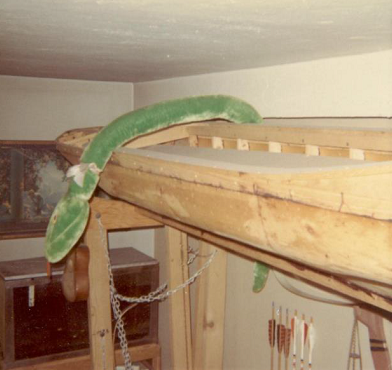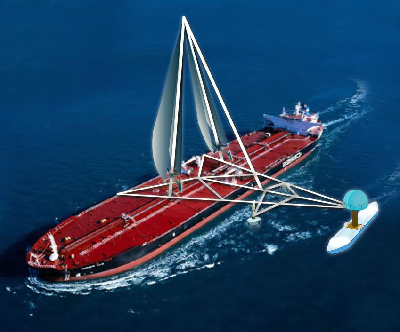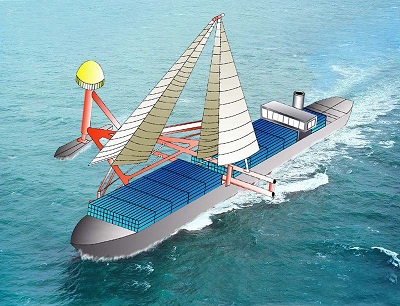Building a Lifelong Dream

By Frank J. Berté
.png) It was a sunny day in Brooklyn, New York, in the year 1947. A boy of six years old was going to visit his grandfather and grandmother. His grandfather’s name was Frank J. Berté, the same as the boy’s. Whenever he would visit his grandfather’s home this boy would always explore the house in great detail, but his favorite thing in the house was a six foot long model sailboat that his grandfather had built.
It was a sunny day in Brooklyn, New York, in the year 1947. A boy of six years old was going to visit his grandfather and grandmother. His grandfather’s name was Frank J. Berté, the same as the boy’s. Whenever he would visit his grandfather’s home this boy would always explore the house in great detail, but his favorite thing in the house was a six foot long model sailboat that his grandfather had built.
The boy’s father Dominic J. Berté, had told the boy all about his grandfather’s life in the small town of Malazzo, Sicily, and how creative he was. When the man’s grandfather was twelve years old, he ran away and became a cabin boy on a square rigger sailboat. After living in Sicily, Buenos Aires and Argentina, when he finally settled down for the last time, it was in Brooklyn, New York.
Here, he became a brick layer, but after an accident on some scaffolding, he was hurt and could not lay bricks any longer. He had some time on his hands and the love of sailboats was still in his heart, so he joined a club that used to race model sailboats on the lake in Prospect Park. He observed the races and studied the design of the various models being sailed. Finally he built his own model sailboat, and his wife made the sails on her sewing machine. The boat was a work of art; every part of it was beautiful. It was even more amazing that the boat had been made with so few tools, and in such a limited space as available in the small apartment that the boys’ grandparents lived.
 Eventually the boy’s grandfather and grandmother died, and the boy asked his father if he could have the grandfather’s model sailboat. Unfortunately the boy’s apartment was smaller than that of his grandfather and there was no room for the boat - he was so disappointed.
Eventually the boy’s grandfather and grandmother died, and the boy asked his father if he could have the grandfather’s model sailboat. Unfortunately the boy’s apartment was smaller than that of his grandfather and there was no room for the boat - he was so disappointed.
Soon after, the boy started trying to build his own model sailboat in his family’s apartment in the Bronx. He was always building something. His parents let him have one half of the hall closet for his shop in their small apartment. One half of the closet had his workbench and the other half held the families coats. He wanted to build a square rigger. He knew that a sailboat had a keel and ribs, so working in his closet shop, he split wooden clothes pins in half and tried to nail them together. This didn’t work; the wood kept splitting.
When the boy was in high school, he finally got his own room, which he immediately converted into a workshop/bedroom. He decided to try to build the model square rigger again, this time from balsa wood, which was available from hobby shops. He made the keel, and the ribs, and the planking on the sides and cast a lead weight for the ballast. The model came out well and sailed well. The boy even put cannons (powered by firecrackers) on the boat which he called the Buccaneer.
Then the boy graduated from high school and went to Bronx Community College. During the summer months the boy designed and built a trimaran. He built the 12 footer in his bedroom. Construction of the sailboat required cutting oak planks into strips to make the ribs. This process was carried out by pushing the 12 foot long boards from the front door of the apartment through a saw mill device in the living room and into the parents’ bedroom. Fortunately his parents, Dominic and Rose, were very understanding.
.png) The hull and the two outriggers were made, and then this sailboat was put on a parallelogram rig that moved the boat to the middle of the bedroom when it was to be worked on, and up above the boys’ bed when it was stowed away for the night. The boat stayed in this room for years while the boy graduated from college, went to graduate school and got married.
The hull and the two outriggers were made, and then this sailboat was put on a parallelogram rig that moved the boat to the middle of the bedroom when it was to be worked on, and up above the boys’ bed when it was stowed away for the night. The boat stayed in this room for years while the boy graduated from college, went to graduate school and got married.
The boy now was a man with a family and two young sons, Frank and Nick. As Frank grew the man decided to build him a model catamaran, but this time he would design a sail boat based on engineering principles and not just what historically what had been done. This was the Eureka Moment, which dominated the remainder of his life. He started sketching the new design concept which utilized a triangular deck and a tetrahedral space frame. He purchased dowels sticks, kite string, silicone glue, aluminum foil and Styrofoam cups. Using these materials he built the first model Tridactyl. It had aluminum foil sails and Styrofoam cups - glued open end to open end for hulls.
He took it out past the breakers at the beach and let it sail. The wind blew it back toward the shore right through the breakers. The Tridactyl sailed perfectly in the strong onshore winds and sailed right through the breakers without capsizing. The man and his sons were so happy.
The man built another small model of the Tridactyl using plumbing fittings and copper tubing and took it to Massachusetts Institute of Technology (MIT). Fortuitously, MIT had just opened an Innovation Center, funded by the National Science Foundation with the objective of fostering innovation in the U.S. A presentation was made to a committee, and they recommended that the patent for the craft be funded.
.png) Under this arrangement MIT would fund the patent application process; in return the man would share the royalties from sale of the production rights. This contract lasted three years, during which time a number of presentations were made to representatives of U.S. sailboat manufacturers.
Under this arrangement MIT would fund the patent application process; in return the man would share the royalties from sale of the production rights. This contract lasted three years, during which time a number of presentations were made to representatives of U.S. sailboat manufacturers.
During this time the man decided to build the next model from aluminum, so that the models would be lighter (as opposed to making them out of copper). Soon after, he immediately was confronted with a problem with the hulls, since prior hulls were made from Styrofoam or wood. He could not form a typical sleek hull from aluminum since he didn’t have the right tools. He started thinking about what he could do under the limitation that the hulls had to be built with flat pieces of aluminum.
Eventually he figured out that a hull with a square cross section would actually be superior to the typical v shaped hull. In addition he added a foil on the front of the hulls to eliminate the bow wave even at low speeds. He performed hull testing on his own, and at the MIT towing tank, and the results verified that these principles were valid.
The representatives of the companies that made sailboats and sporting gear were impressed with the concept as was presented to them at MIT, but stated that their U.S. based companies were probably too conservative to get involved. After the three year period the patent rights reverted to the man, and following the direction suggested by MIT, the man formed Innovative Technology Inc. in order to raise the capital required to fabricate and test the first full scale prototype.
 The construction process took almost ten years, because the man had to work in his spare time. The man’s sons now had families of their own, and by the time the Tridactyl was ready to launch there was a crowd of people at the launch site, and a few police cars observing the unfolding saga. Horns tooted and people clapped as the Tridactyl was launched. It sailed, but there were some mast rotation and hull rotation problems, and more test trials and modifications were carried out.
The construction process took almost ten years, because the man had to work in his spare time. The man’s sons now had families of their own, and by the time the Tridactyl was ready to launch there was a crowd of people at the launch site, and a few police cars observing the unfolding saga. Horns tooted and people clapped as the Tridactyl was launched. It sailed, but there were some mast rotation and hull rotation problems, and more test trials and modifications were carried out.
After a few more years of effort the man decided that there should be a major design modification on the sails. He changed the name of his company to Innovative Marine Technology (IMT), and he redesigned the whole Tridactyl.
On June 19, 2005, (the man’s birthday), the Tridactyl Mark III model sailed with all functions operational. The latest ecto-rudder/ dagger board structure all worked as planned. The man was assisted by his two sons, Frank and Nick, and their children.
On December 10, 2009, after three more years of modifications and experimentation he finally submitted the Third Generation Tridactyl Sailboat Patent Application to the U.S. Patent and Trade Mark Office.
Not content, he had the idea to transform the Tridactyl into the Cargoproa concept that could be used for the propulsion of cargo and tanker vessels on the trans-ocean portion of their voyage under pure sail power. Another provisional patent was submitted. Design and construction of a 24 foot scale model Cargoproa was initiated, but progress was slow. The plan was to complete the construction of the model Cargoproa and test it at the Massachusetts Maritime Academy in April 2012.
 Finally on August 21, 2013 the Cargoproa, which had been disassembled at its location in the backyard of the man’s home, was re-assembled, coupled to and tested on the Massachusetts vessel at the MMA’s Great Herring Pond Facility in Plymouth, Massachusetts. It weighed just 600 pounds but propelled the 20,000 pound Massachusetts vessel.
Finally on August 21, 2013 the Cargoproa, which had been disassembled at its location in the backyard of the man’s home, was re-assembled, coupled to and tested on the Massachusetts vessel at the MMA’s Great Herring Pond Facility in Plymouth, Massachusetts. It weighed just 600 pounds but propelled the 20,000 pound Massachusetts vessel.
The test was successful in that the sail area provided by the Cargoproa was able to propel the MMA vessel at about 3.5 to 4 knots without the use of the vessel’s engine, at the same speed the vessel could achieve with just the use of its engine, in both broad reach and downwind sailing configurations.
From the testing, the coupling of the Cargoproa should be no problem if it were coupled to a tanker vessel. On the other hand coupling to a container ship would be problematic, so a new design configuration was required to make this coupling feasible. Early in February 2014, design improvements for coupling to container vessels were prepared and a patent submitted.
And the saga continues…..
